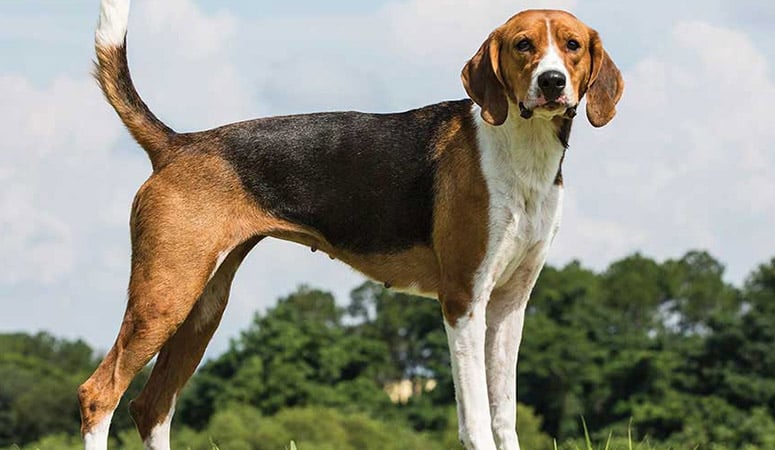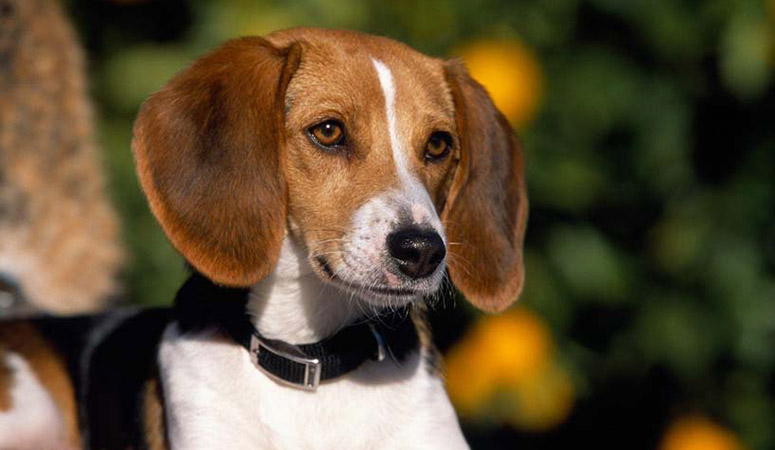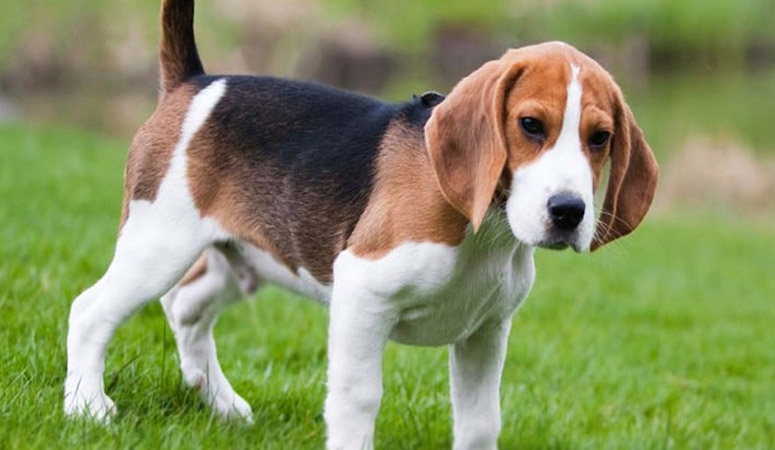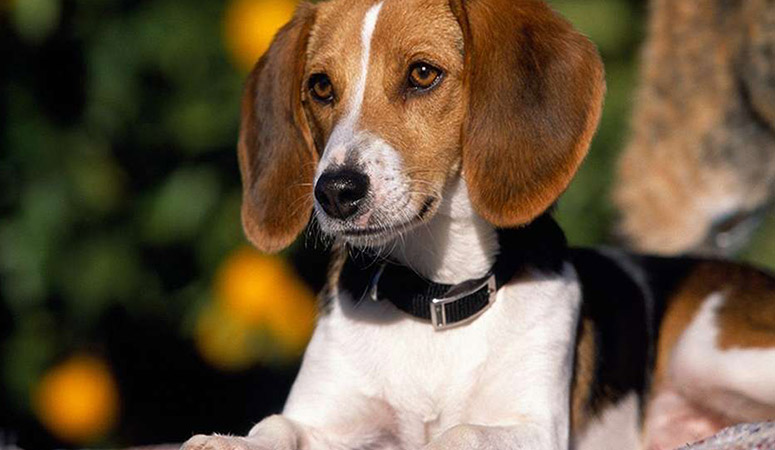American Foxhound

The American Foxhounds have slighter bone and higher leg, which give him greater speed and agility over rough terrain. This breed has good nature and requires low maintenance with hard coat of medium length. They are bred to hunt an array of quarry, such as squirrels, deer, raccoons, coyotes, foxes, and bears. Easygoing, sweet, kind, and loyal, the American Foxhound gets on well with kids, dogs, even cats, but comes with special considerations for prospective owners.
| Other Names | FoxHound |
| Color | Black White & Tan, White Black & Tan |
| Height | Males: 22-25 inches. Females: 21-24 inches. |
| Weight | Males: 60-75 pounds. Females: 60-75 pounds. |
| Life Span | 11-13 years |
| Personality | Independent, Easy-Going, Sweet-Tempered |
| Exercise | Needs Lots of Activity |
| Origin |
| Popularity | #189 |
| Groom Needs | Occasional Bath/Brush |
| Kids Friendly | Yes |
| Dog Friendly | Yes |
| Watch Dog | |
| Family Dog | Yes |
| Litter Size | 5-7 puppies |
American Foxhound Pictures
American Foxhound Video
Introduction
The American Foxhound is normally a good-natured dog with a sweet demeanor, calm and gentle. They make good friends with children, loyal companions to the family, and, yet, often shy and reserved around people they aren’t familiar with. This dog requires a lot of exercise due to its high level of activity. Their long legs come in handy for their swift and hasty pursuit of quarry. Early as possible, they should be trained in obedience as they may develop a natural tendency to be independent. They come in a short, hard coat that is close to the body. The prevalent colors of the American Foxhound include blue, red, black and tan, and a tricolor.
Males of this breed normally stand 22-25 inches from shoulder to paw and weigh around 60-70 pounds at maturity. A full-grown female stands 20-24 inches tall, measured at the shoulder, and likely to tip the weighing scale towards 65 pounds. They are classified as members of the Hound Group by the American Kennel Club (AKC). The American Foxhound has an average lifespan of 10-13 years.
Living with American Foxhound
It is easy to groom the American Foxhound’s short, dense coat. The dogs shed moderately, and regular brushing will help prevent loose hair from settling on your floors, furniture, and clothing.
Weekly brushing with a hound mitt or rubber curry brush can help remove dead hairs and distribute skin oils. The Foxhound should not need to be bathed unless he gets into something particularly messy while outdoors.
Trim nails regularly as short, neatly trimmed nails keep the dog’s feet in good condition and protect your legs from getting scratched when your Foxhound enthusiastically jumps up to greet you. Handle his paws frequently — dogs are touchy about their feet — and look inside his mouth and ears.
Brush your Foxhound’s teeth at least two or three times a week to remove tartar buildup and the bacteria that lurk inside it. Of course daily brushing is even better if you want to prevent gum disease and bad breath.
Check the ears on a regular basis for signs of wax buildup, irritation or infection. And clean them with a cotton ball and a veterinarian-approved cleanser. Your careful weekly exam will help you spot potential health problems early.
Begin to get your Foxhound used to being brushed and examined from his puppyhood. Make grooming a positive experience, filled with praise and rewards, and you’ll lay the groundwork for easy vet exams and other handling when he’s an adult.
The American Foxhound needs at least a solid hour or two of exercise every day to burn off his energy and keep healthy. If they get all the activity they need, they can fit in pretty much anywhere; but if not, he may become bored and destructive.
While they are happiest living indoors with their human family, American Foxhounds make great companions on long walks or hikes. The breed also exercises mind and body by participating in canine sports such as tracking, rally, coursing ability tests, and other activities that can be enjoyed together by dog and owner.
As a hard-working hunting dog, this breed can be used as a tracker in the field. They will keep going and going for hours without become tired. Once they catch a scent, they will follow it without distraction.
Foxhounds have strong instinct to chase after prey, so they should only be allowed loose in areas that are securely fenced, and any walks must be taken on a leash.
The Foxhound isn’t a lone wolf, so to speak. It loves people and other dogs. The more, the merrier – bring home a couple of dogs to company the American Foxhound.
The American Foxhound should do well on high-quality dog food. And the recommended daily amount is about 2 to 3 cups. But the amount of your dog diet depends on his size, age, build, metabolism, and activity level.
The quality of dog food you buy also makes a difference — the better the dog food, the further it will go toward nourishing your dog and the less of it you’ll need to shake into your dog’s bowl.
Hounds like to eat. You should serve and give meals twice a day rather than leaving food out all the time to prevent from being overweight. And treats can be an important aid in training, but giving too many can cause obesity, which can shorten a dog’s life by several years so it’s important to keep an eye on their waistline from the word go.
Clean, fresh water should be available at all times.
Learn about which human foods are safe for dogs, and which are not. Check with your vet if you have any concerns about your dog’s weight or diet.
This is typically a healthy breed, which isn’t known to have any hereditary illnesses. On rare occasions, an American Foxhound may have hip dysplasia and thrombocytopathy, caused by poorly functioning platelets, which will lead to abnormal or excessive bleeding from minor bumps or cuts.
Not all American Foxhounds will get any or all of these diseases, but it’s important to be aware of them if you’re considering this breed.
Long-eared breeds can develop ear infections, and a Foxhound’s ears should be checked regularly to remove foreign matter and avoid a buildup of wax.
Regular brushing with a toothpaste designed for dogs can help keep the hound’s teeth healthy as well.
Responsible breeders test all breeding stock for conditions that can affect the breed. Regular visits to the vet for checkups and parasite control help to ensure the dog a long, healthy life.
Total Annual Cost: $3177.9
Cost is estimated for the first year and may vary depending on many factors, such as dog food, health care, leash, collar, licensing, possible fencing, crates, training and obedience classes, dog-walking, grooming, treats, toys, flea, tick, and heart-worm meds, microchips, etc.
American Foxhounds are easygoing and amiable. They also can be stubborn and independent, however, which can make training a bit hard.
Although Foxhounds are mild-tempered, devoted, and easygoing companions, and get along well with children, the owners will need patience and persistence when training them, or hounds can develop unwanted behaviors.
Obedience training is highly recommended to help the independent Foxhound view you as leader of the pack. As scenthounds, they may never be safe to let them off-leash, because their noses can lead them into trouble.
Also early socialization and puppy training classes are recommended.
The breed won’t respond well to punishment-based training, so use treats and praise to reward him for doing as you ask. And “ask” is the operative word. Hounds will flat-out ignore you if you try to boss them around. Keep an old Southern adage in mind when training an American Foxhound: you catch more flies with honey than with vinegar.
History
The American Foxhound was developed as an offshoot of the English Foxhounds around the mid-1600s. In 1650, Robert Brooke was said to have sailed across Europe into the Americas, specifically the Crown Colony in North America. He brought along his English Foxhounds which were pack-hunting dogs bred mainly to down foxes. These dogs were successful in England, so it was welcomed with optimism into America. Years of breeding brought the Brooke’s breed of dogs to the attention of Americans, especially George Washington who was popular with foxhounds during his lifetime. These dogs are believed to be ancestors to the American Foxhound and several Coonhounds. The American Foxhound is one of the few indigenous breeds of the United States, developed in Virginia from the English Foxhounds (Brooke’s dogs forming the foundation), the French Hound, and the Irish Foxhound.
The increased importation of French Hounds in America around the 1700s, and the surge of Irish Foxhounds in the 1830s, were the boon for the improvement and subsequent strengthening of the gene strains of the American Foxhound (the French Hounds were bred in to increase the size of the American Foxhound, while the Irish Foxhound served for speed). Subsequently, further refinement of the breed was carried out to make it distinct from the English Foxhound. The American Foxhound is currently the state dog of Virginia. It was recognized by the American Kennel Club (AKC) in 1886, alongside eight other breeds.
Helpful Information
Breed Club:
Breed Club Rescue: Carolina Coonhound Rescue
Breed Club Rescue Link: http://www.carolinacoonhoundrescue.com/index.html




